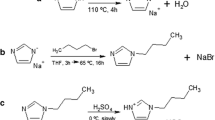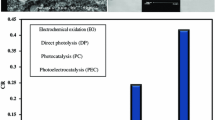Abstract
Electrochemical oxidative degradation of diazo dye Amido black 10B (AB10B) as model pollutant in water has been studied using nanostructured ZnO-TiO2 thin films deposited on graphite felt (GrF) substrate as anode. The influence of various operating parameters, namely the current intensity, the nature and concentration of catalyst, the nature of electrode materials (anode/cathode), and the adsorption of dye and ambient light were investigated. It was found that the oxidative degradation of AB10B followed pseudo first-order kinetics. The optimal operating conditions for the degradation of 0.12 mM (74 mg L−1) dye concentration and mineralization of its aqueous solution were determined as GrF-ZnO-TiO2 thin film anode, 100 mA current intensity, and 0.1 mM Fe2+ (catalyst) concentration. Under these operating conditions, discoloration of AB10B solution was reached at 60 min while 6 h treatment needed for a mineralization degree of 91 %. Therefore, this study confirmed that the electrochemical process is effective for the degradation of AB10B in water using nanostructured ZnO-TiO2 thin film anodes.








Similar content being viewed by others
References
Aboul-Gheit AK, El-Desouki DS, El-Salamony RA (2014) Different outlet for preparing nano-TiO2 catalysts for the photodegradation of Black B dye in water. Egypt J Pet 23:339–348
Arslan I, Balcioglu IA, Bahnermann DV (2000) Advanced chemical oxidation of reactive dyes in simulated dyehouse effluents by ferrioxalate-Fenton/UV-A and TiO2/UV-A processes. Dyes Pigments 47:207–218
Brillas E, Martinez-Huitle CA (eds) (2011) Synthetic diamond films: preparation, electrochemistry, characterization, and applications. Wiley, New Jersey
Brillas E, Martínez-Huitle CA (2015) Decontamination of wastewaters containing synthetic organic dyes by electrochemical methods. An updated review. Appl Catal B Environ 166:603–643
Brillas E, Sirés I, Oturan MA (2009) Electro-Fenton process and related electrochemical technologies based on Fenton’s reaction chemistry. Chem Rev 109:6570–6631
Chung KT (2015) Occurrence, uses, and carcinogenicity of arylamines. Front Biosci 7:322–345
de Araujo DM, Canizares P, Martinez-Huitle CA, Rodrigo MA (2014) Electrochemical conversion/combustion of a model organic pollutant on BDD anode: role of sp(3)/sp(2) ratio. Electrochem Comm 47:37–40
de Araujo DM, Saez C, Martinez-Huitle CA, Canizares P, Rodrigo MA (2015) Influence of mediated processes on the removal of Rhodamine with conductive-diamond electrochemical oxidation. Appl catal B-Environ 166:454–459
Diagne M, Sharma VK, Oturan N, Oturan MA (2014) Depollution of indigo dye by anodic oxidation and electro-Fenton processes using boron-doped diamond anode. Environ Chem Lett 12:219–224
Dinesh VP, Biji P, Ashok A, Dhara SK, Kamruddin M, Tyagi AK, Raj B (2014) Plasmon-mediated, highly enhanced photocatalytic degradation of industrial textile dyes using hybrid ZnO@Ag core-shell nanorods. RSC Adv 4:58930–58940
Dirany A, Sirés I, Oturan N, Özcan A, Oturan MA (2012) Electrochemical treatment of Sulfachloropyridazine: kinetics, reaction pathways, and toxicity evolution. Environ Sci Technol 46:4074–4082
El-Ghenymy A, Rodríguez RM, Brillas E, Oturan N, Oturan MA (2014) Electro-Fenton degradation of the antibiotic sulfanilamide with Pt/carbon-felt and BDD/carbon-felt cells. Kinetics, reaction intermediates and toxicity assessment. Environ Sci Pollut Res 21:8368–8378
Es-Souni M (2011) Coating for polymers, European patent nr. EP2707438 (https://www.google.com/patents/EP2707438A1?cl=en)
Guivarch E, Trevin S, Lahitte C, Oturan MA (2003) Degradation of azo dyes in water by electro-Fenton process. Environ Chem Lett 1:39–44
Hisaindee S, Meetani MA, Rauf MA (2013) Application of LC-MS to the analysis of advanced oxidation process (AOP) degradation of dye products and reaction mechanisms. Trends Anal Chem 49:31–44
Kirupavasam EK, Raj GAG (2012) Photocatalytic degradation of Amido black-10B using nanophotocatalyst. J Chem Pharm Res 4:2979–2987
Labiadh L, Oturan MA, Panizza M, Ben Hamadi N, Ammar S (2015) Complete removal of AHPS synthetic dye from water using new electro-Fenton oxidation catalyzed by natural pyrite as heterogeneous catalyst. J Hazard Mater 297:34–41
Lahkimi A, Chaouch M, Oturan N, Oturan MA (2007) Removal of textile dyes from water by electro-Fenton process. Environ Chem Lett 5:35–39
Lin H, Wu J, Oturan N, Zhang H, Oturan MA (2016) Degradation of artificial sweetener saccharin in aqueous medium by electrochemically generated hydroxyl radicals. Environ Sci Pollut Res 23:4442–4453
Martinez-Huitle CA, Quiroz MA, Comninellis C, Ferro S, De Battisti A (2004) Electrochemical incineration of chloranilic acid using Ti/IrO2, Pb/PbO2 and Si/BDD electrodes. Electrochim Acta 50:949–956
Mirkhani V, Tangestaninejad S, Moghadam M, Habibi MH, Rostami-Vartooni A (2009) Photodegradation of aromatic amines by Ag-TiO2 photocatalyst. J Iran Chem Soc 6:800–807
Olvera-Vargas H, Oturan N, Aravindakumar CT, Sunil Paul MM, Sharma VK, Oturan MA (2014) Electro-oxidation of the dye azure B: kinetics, mechanism and by-products. Environ Sci Pollut Res 21:8379–8386
Oturan MA (2014) Electrochemical advanced oxidation technologies for removal of organic pollutants from water. Environl Sci Pollut Res 21:8333–8335
Oturan MA, Aaron JJ (2014) Advanced oxidation processes in water/wastewater treatment: principles and applications. A review. Crit Rev Environl Sci Technol 44:2577–2641
Oturan N, Trajkovska S, Oturan MA, Couderchet M, Aaron JJ (2008) Study of the toxicity of diuron and its metabolites formed in aqueous medium during application of the electrochemical advanced oxidation process “electro-Fenton”. Chemosphere 73:1550–1556
Oturan N, Brillas E, Oturan MA (2012) Unprecedented total mineralization of atrazine and cyanuric acid by anodic oxidation and electro-Fenton with a boron-doped diamond anode. Environ Chem Lett 10:165–170
Panizza M, Cerisola G (2009) Direct and mediated anodic oxidation of organic pollutants. Chem Rev 109:6541–6569
Panizza M, Dirany A, Sirés I, Haidar H, Oturan N, Oturan MA (2014) Complete mineralization of the antibiotic amoxicillin by electro-Fenton with a BDD anode. J Appl Electrochem 44:1327–1335
Qamar M, Saquib M, Muneer M (2005) Photocatalytic degradation of two selected dye derivatives, chromotrope 2B and Amido black 10B, in aqueous suspensions of titanium dioxide. Dyes Pigments 65:1–9
Rocha JHB, Solano AMS, Fernandes NS, da Silva DR, Peralta-Hernandez JM, Martinez-Huitle CA (2012) Electrochemical degradation of Remazol red BR and Novacron blue C-D dyes using diamond electrode. Electrocatalysis 3:1–12
Rodrigo MA, Oturan N, Oturan MA (2014) Electrochemically assisted remediation of pesticides in soils and water: a review. Chem Rev 11:8720–8745
Sen S, Demirer GN (2003) Anaerobic treatment of real textile wastewater with a fluidized bed reactor. Water Res 37:1868–1878
Senthilkumar S, Perumalsamy M, Janardhana Prabhu H (2014) Decolourization potential of white-rot fungus Phanerochaete chrysosporium on synthetic dye bath effluent containing Amido black 10B. J Saudi Chem Soc 18:845–853
Shukla S, Oturan MA (2015) Dye removal via electrochemistry and oxidation using semiconductor oxides nanotubes. Environ Chem Lett 13:157–172
Sirés I, Brillas E, Oturan MA, Rodrigo M, Panizza M (2014) Electrochemical advanced oxidation processes: today and tomorrow. A review. Environ Sci Pollut Res 21:8336–8367
Solozhenko EG, Soboleva NM, Goncharuk VV (1995) Decolourization of azodye solutions by Fenton’s oxidation. Water Res 29:2206–2210
Sun JH, Sun SP, Wang GL, Qiao L (2007) Degradation of azo dye Amido black 10B in aqueous solution by Fenton oxidation process. Dyes Pigments 74:647–652
Tan KB, Vakili M, Hord BA, Poh PE, Abdullah AZ, Salamatinia B (2015) Adsorption of dyes by nanomaterials: recent developments and adsorption mechanisms. Separ Purif Technol 150:229–242
Toh YC, Yen JJL, Obbard JP, Ting YP (2003) Decolourisation of azo dyes by white-rot fungi (WRF) isolated in Singapore. Enzym Microb Technol 33:569–575
Vasudevan S, Oturan MA (2014) Electrochemistry: as cause and cure in water pollution—an overview. Environ Chem Lett 12:97–108
Author information
Authors and Affiliations
Corresponding author
Additional information
Responsible editor: Philippe Garrigues
Rights and permissions
About this article
Cite this article
El-Kacemi, S., Zazou, H., Oturan, N. et al. Nanostructured ZnO-TiO2 thin film oxide as anode material in electrooxidation of organic pollutants. Application to the removal of dye Amido black 10B from water. Environ Sci Pollut Res 24, 1442–1449 (2017). https://doi.org/10.1007/s11356-016-7920-6
Received:
Accepted:
Published:
Issue Date:
DOI: https://doi.org/10.1007/s11356-016-7920-6




